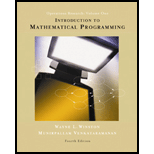
Concept explainers
Explanation of Solution
Calculation to obtained the maximizes the NPV from the given investment:
The Net Present Value (NPV) of an investment is the amount by which the investment will increase the firm’s value.
Assuming the annual rate interest, “r = 0.10”, the user can compute the NPV for investment 1 as,
Now, the user computes the NPV for investment 1 as,
Therefore, the NPV of investment 1 is larger than investment 2.
Let, “x1” be the fraction of investment 1 that is undertaken and “x2” be the fraction of investment 2 that is undertaken.
The objective function is to maximize the NPV of the investment.
Therefore, maximize
Constraint 1:
At time 0, $10000 is available for investment
Trending nowThis is a popular solution!

Chapter 3 Solutions
Introduction to mathematical programming
- Suppose the risk index for the stock fund (the value of ) increases from its current value of 8 to 12. How does the optimal solution change, if at all? Suppose the risk index for the money market fund (the value of ) increases from its current value of 3 to 3.5. How does the optimal solution change, if at all? Suppose increases to 12 and increases to 3.5. How does the optimal solution change, if at all?arrow_forwardConsider that there are four items that can fit inside a 13-pound-capacity backpack. The respective weights of the items are 5.7, 4, and 3 pounds. Their respective utilities are 8, 11, 6, and 4 utils. Determine the optimal solution that maximizes the overall usefulness of the backpack.arrow_forward
 Operations Research : Applications and AlgorithmsComputer ScienceISBN:9780534380588Author:Wayne L. WinstonPublisher:Brooks Cole
Operations Research : Applications and AlgorithmsComputer ScienceISBN:9780534380588Author:Wayne L. WinstonPublisher:Brooks Cole
